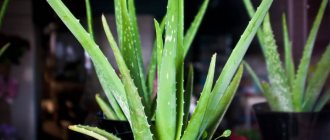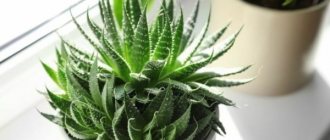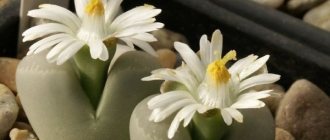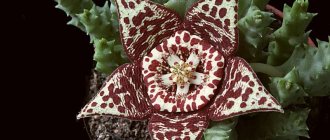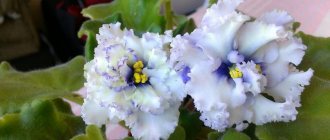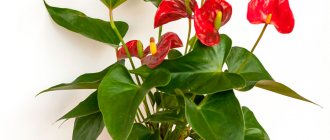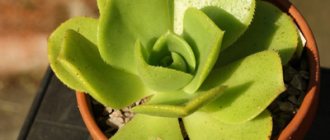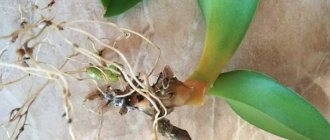Among amateur gardeners who prefer growing succulents, unpretentious and attractive even during the dormant period, slipway enjoys constant popularity. The name of this unusually beautiful flower, which, in contrast to its appearance, has a monstrously unpleasant odor, is associated with the name of the 17th century Dutch physician Johann Bodeus van Stapel, who became the discoverer of the bizarre plant.
Due to its expressive appearance, this succulent is also called the fluffy stargazer, order star, African starfish and stapelia cactus.
Botanical description of succulent
Stapelia is a genus of perennial succulent plants belonging to the Apocynaceae family.
All varieties of slipway have characteristic common features:
- They have absolutely no leaves, and numerous fleshy, tetrahedral stems branching at the base of a silver-blue or green color, sometimes with a pink-violet tint, covered along the edges with blunt teeth, have a thickness of up to 3 cm, and reach a height of from 10 to 60 cm.
- The main feature of the plant is its unusually beautiful and at the same time foul-smelling large flowers, single or paired, with five petals, located on bent pedicels (usually at the base, less often at the tops of the shoots), having a diameter of 5 to 30 cm and the shape similar to a starfish. The surface of the petals is covered with fluffy hairs; the color can be different, both plain and variegated.
- The root system of the crop is superficial and rather poorly developed.
How to propagate correctly?
Stapelia flower: photo of succulent
Stapelia is very easily propagated using cuttings. In order to prepare them, you need to use a well-sharpened knife. Before use, it must be treated with a disinfectant. Those places on the bush and cuttings where the cut was made must be treated with crushed charcoal.
Before planting, Stapelia cuttings need to be kept in the open air for several hours. Then the cuttings are planted in soil, which should include coarse sand, as well as a small amount of crushed peat. When the cuttings have formed a root system, the plants need to be transplanted into separate pots. The mixture in which the plants are planted should consist of leaf soil, turf and coarse sand. All components are mixed in equal quantities. It would also be a good idea to add charcoal (one handful).
In addition to cuttings, you can also use the seed propagation method of Stapelia. Stapelia seeds can only be obtained from a fully ripened fruit. This ripening occurs after at least a year. After the seeds ripen, sowing is done. For this purpose, containers filled with light sandy soil are used. Sprouts usually appear twenty to thirty days from the moment of sowing. When the Stapelia plants get a little stronger and grow, they are transplanted into separate pots. The soil used is the same as for replanting.
After about twelve months, Stapelia is transplanted into a larger container, the transverse part of which should already be nine to ten centimeters. Stapelia is transplanted by transshipment. It is worth remembering that when propagating a slipway from seed, there is a risk that the characteristics of the variety from the mother bush may not be preserved.
Unusual smell
This succulent smells differently than most flowers: instead of a pleasant aroma, the elegant plant exudes the smell of carrion.
This attracts its only pollinators in the wild - flies - and thus contributes to the successful pollination process.
Some varieties of stapelia during flowering have a neutral smell or even emit a light waxy aroma. But during this period it is better to take the rest out onto the loggia, veranda or balcony.
Pests
To preserve your favorite flower, you need to know what pests damage the slipway; home care consists of inspecting the stems and timely treatment with insecticides.
The flower can be attacked by insects such as aphids, mealybugs and spider mites; they create a real problem for flower growers. They all feed on the sap of the plant. The tree is especially vulnerable if it is kept on the balcony, because all sorts of winged creatures can get there from the street and harm the flower.
The stapelia cactus is easy to care for; even a novice gardener can handle growing it. If you properly care for the crop, it can bloom in its second year. It is worth getting this plant to delight yourself and your guests with flowers with an unusual description.
Poisonous or not?
Stapelia is a toxic plant: contact with the milky juice contained in the shoots on the skin or mucous membranes causes redness, irritation, itching and burns, and consumption of the stems leads to poisoning.
Therefore, when in contact with a flower, you need to wear gloves, and at the first signs of poisoning in children or animals, immediately give the victim Enterosgel and consult a doctor.
Dealing with problems
It is quite easy to care for the slipway. However, sometimes flower growers have problems; it is important to find out in time why they appear and then overcome them.
Methods for eliminating care errors - table
| Problems | Causes | Solutions |
| No flowering |
|
|
| Yellowing of shoots | Insufficient lighting. |
|
| The appearance of brown spots | Sunburn of stems. | Move the plant to a place out of direct sunlight. |
| Stems become soft | Drying of roots. | Ensure adequate watering |
| The emergence of diseases and pests | Stapelia is resistant to diseases and pests; it suffers most from waterlogging in the cold season, which causes fungal diseases. |
|
Benefits and harms
In addition to the fact that the flower is poisonous and requires careful handling, data about the beneficial or harmful qualities of the plant are more related to signs and superstitions than to real facts.
It is believed that the slipway:
- absorbs magnetic radiation;
- protects against the evil eye;
- promotes prosperity and success in business;
- calms the nervous system and heals mental wounds;
- helps get rid of bad habits;
- creates a pleasant atmosphere in the house;
- charges the body with positive energy.
Everyone can check whether this is really so.
Species names
Up to 56 varieties of slipway are known, which have much in common, but there are also differences, especially with regard to the size, color and smell of flowers. Below are popular indoor types with photos and descriptions.
Variegated or variegated
Stapelia variegate reaches a height of 10-15 cm and during the flowering period it looks very elegant and attractive. The juicy stems are green with a pink tint, round in cross-section, have blunt teeth at the edges, and at the base of the young shoots there are up to 5 flowers with a diameter of 5-7 cm with cream or yellow petals, pointed at the edge and covered with dark burgundy specks or stripes .
During the flowering period, Stapelia variegate emits a rather strong unpleasant odor.
Large-flowered (Grandiflora)
Stapelia grandiflora reaches only 9-10 cm in height. At the same time, it produces large flowers with a diameter of 15 cm with five lanceolate petals, curved outward at the edges and covered with silvery hairs. The tetrahedral green shoots of the plant have sparse denticles along the edges, and the flower petals are blue-greenish on the outside and dark purple on the inside (less often, purple or orange). When flowering, the succulent emits a distinct smell of rotting meat.
Gigantea or Gigantea
Stapelia gigantea, which is also called tiger because of the color of the petals, pale yellow or pink and covered with dark red hairs. Tetrahedral stems with curved teeth on the ribs grow up to 25 cm in height, and huge flowers with a diameter of 30-35 cm, located on long stalks, have elongated, narrowed and slightly curved petals at the edge.
Stapelia gigantean has an important advantage: during flowering there is absolutely no rotten smell, which is so characteristic of most varieties of the plant.
Ferruginous
Stapelia glanduliflora, 15 cm high, has straight, light green shoots 3 cm thick, with wing-shaped edges covered with sparse teeth. The succulent blooms with yellow-green flowers up to 5 cm in diameter with pointed triangular-shaped petals, the edges of which are slightly bent, and the surface, covered with pinkish stripes and specks, is densely pubescent with long (up to 2 cm) white hairs with club-shaped thickenings. Each bush blooms from 1 to 3 flowers located on long peduncles.
Star-shaped
Stapelia asterias has green or reddish stems reaching 20 cm in height.
Flowers about 10 cm in diameter with sharp, tuberous petals of brown-red, orange or yellow color, covered with pale pink hairs and thin yellow stripes, are located on long stalks at the base of annual shoots, in groups of 2-3 buds.
A characteristic feature of Stapelia asterias is that during the flowering period, instead of a putrefactive odor, it emits a faint aroma of wax.
Golden purple
Stapelia flavor-purpurea with green or purple shoots and teeth on their blunt edges grows up to 10-13 cm. On the tops of young stems, from 1 to 3 flowers with a diameter of 4-5 cm of golden yellow or burgundy color with long sharp petals bloom, smooth outside and wrinkled inside, the edges of which are strongly curved towards the peduncle. The aroma of Stapelia flavor-purpurea, unlike many of its relatives, is quite pleasant and light.
Changeable
Stapelia mutabilis is a hybrid up to 15 cm high with strong fleshy stems and upward-pointing teeth on the edges.
The flowers, placed on long stalks, have yellow-greenish ovoid-triangular petals, pubescent along the edges with cilia and painted with burgundy dots and stripes.
Christata
Stapelia leendertziae cristata or, in its entirety, Stapelia leendertziae cristata, is shaped like a fragment of a coral reef. Its wide green stems with a pink border at the edges are like wavy combs, and the oblong flowers look like crimson bells.
Khirsuta
Stapelia hirsuta has smooth shoots, with teeth only in the lower part. The diameter of the purple-brown flowers when opened is no more than 10 cm. The surface of the petals seems velvety thanks to the lilac hairs and thin transverse stripes covering it.
Desmetiana
Stapelia desmeniana is a fairly large plant, the height of its tetrahedral stems reaches 30 cm.
The purple color of the petals, dotted with pink fibers, makes this variety especially decorative.
Erect-flowered
Stapelia erectiflora grows no more than 15 cm in height. The small flowers look very unusual: inside a fleecy corolla with petals strongly curved towards the stem there is a bright orange-brown star with a light yellow center. Stapelia erectiflora blooms for a short time, from one to two weeks, while emitting a neutral odor.
Berger
Stapelia bergeriana is a low plant (only 7-10 cm) with grayish-green tetrahedral stems with rounded notches on the edges. At the base of the shoots, beautiful flowers with curved petals bloom on short peduncles. They are yellow at the base, and towards the tips, framed by purple fibers, they gradually acquire a rich lilac-brown color.
Home care
Although slipway is an unpretentious plant, for its normal development it is necessary to know and follow the basic rules of care and maintenance.
Temperature
The optimal ambient temperature for the slipway, as for a seasonal plant, changes throughout the year and is:
- +20…+30 °C - in summer, during the growing season;
- +15…+18 °C - in early spring and late autumn (March and November), when the succulent is resting;
- +10…+14 °C - in winter, during the dormant period.
Maintaining the correct temperature regime in the cold season will ensure full flowering of the plant in the summer.
Location and lighting
The flower needs a sufficient amount of sunlight, and the lighting should be diffused, since exposure to direct rays of the sun can cause burns and subsequent disease of the plant.
The best place to place the slipway is the window sills on the western and eastern sides. And if the apartment has a well-lit loggia, the succulent can be taken there on warm days, while not forgetting to protect the flower from drafts.
Watering and spraying
It is enough to water the crop once a week or even every 10 days, not earlier than the soil is completely dry after the previous moistening, and with the onset of autumn and throughout the winter, the number of waterings should be reduced to once a month. Water the flower from above, generously wetting the soil, but not allowing it to become waterlogged: good drainage will help get rid of excess moisture.
Since slipway comes from places with a dry climate, there is no need to spray it additionally. On the contrary, on sunny summer days it is worth opening the windows more often and ventilating the room to reduce air humidity.
Choosing a pot
The container for the flower should be chosen wide, but not deep, since the root system of the plant is superficial.
At the bottom of the pot with holes for excess moisture to flow out, be sure to lay a drainage layer at least a quarter thick, or even a third of the total height, so that water can pass freely when watering. In this case, the tray into which excess moisture will fall must have sufficiently high sides.
Priming
The most suitable soil mixture for growing slipway is a ready-made substrate for succulents or cacti and orchids. You can add charcoal and fine gravel or sand there.
To prepare the soil yourself, you need:
- Mix in a 1:1:1 ratio:
- leaf soil, which can be taken under birch, aspen or linden trees;
- turf land - it is better to get it outside the city, away from major roads;
- coarse washed river sand or sea shell sand.
- Add crushed charcoal to prevent the development of putrefactive bacteria.
- Disinfect the soil mixture by steaming it in the oven for half an hour at a temperature of 90 °C.
Growing season and dormancy
Stapelia blooms mainly in summer, but sometimes in autumn, for about half a month, and this process begins with the formation of large buds, similar to a chicken egg.
The duration of flowering is influenced by the amount of light received by the plant, favorable temperature conditions and proper care. If the flower feels comfortable, it will bloom longer.
The dormant period, when the plant needs a special, cool temperature regime, begins in November and lasts until the end of March.
When to transplant?
Transplantation is carried out as the flower grows, usually in early spring:
- young specimens are replanted once a year;
- adult plants - once every 2-3 years.
They do it like this:
- Old shoots that are no longer capable of forming flowers are removed from the central part of the bush.
- Prepare a container, not deep, but wider than the previous one, with holes in the bottom.
- Fill one third with drainage, then place a ready-made or home-made, pre-steamed substrate.
- Carefully shake the plant out of the old pot, place it in the center of the new one, filling the free space with soil mixture, and do not water it for 3-4 days.
Top dressing
The plant is fertilized from the beginning of its spring awakening until the onset of flowering.
This is done once every 2 weeks, adding fertilizer during watering and using a ready-made preparation for cacti and orchids, diluted with water in a 1:1 ratio, as a fertilizer.
How to propagate?
At home, stapelia is propagated by seeds, cuttings, or by dividing the rhizome, although the latter method is not always successful.
From seeds
The collected seeds, which will take about a year to fully ripen, are sorted and the tails are removed. Then they are immersed briefly in a weak solution of potassium permanganate.
Then:
- planted in a shallow container filled with wet coarse sand mixed with pieces of peat;
- sprinkle with a thin layer of the same substrate on top;
- until sprouts appear, keep under film, ventilating periodically;
- The sprouts that appear dive into separate containers.
How to root a cutting?
First, use a sharp knife with a disinfected (calcined or treated with alcohol) blade to cut the stalk and leave it for a couple of days to dry the cut, and then:
- prepare a container with a substrate from a mixture of peat and coarse river sand;
- plant the cuttings in the soil mixture;
- to ensure a microclimate, cover with film;
- Once the cuttings have taken root, they are transplanted into a pot with a diameter of 7-8 cm, filled with river sand, leaf and turf soil mixed in equal parts.
Diseases and pests
The most dangerous thing for succulents is waterlogging of the soil: this causes rotting of the rhizomes and death of the entire plant.
The reasons may be:
- violation of the irrigation regime;
- insufficient drainage volume;
- small holes in the bottom of the pot that do not allow excess moisture to pass through well.
If the roots begin to rot, it is better to take healthy shoots to root the cuttings, throw away the soil mixture, and boil the container for 5-10 minutes.
Pests that pose the greatest danger to the slipway:
- mealybug, which gnaws tiny holes in the shoots and introduces putrefactive spores that kill the plant, as a result of which it can no longer be saved, and all that remains is to subject the container to disinfection and treat the window sill with a solution of potassium permanganate;
- spider mites, which can be quickly gotten rid of by thoroughly washing the shoots, as well as wiping the pot and windowsill with a solution of dishwashing detergent.
Why don't buds appear?
One of the reasons for the lack of flowering may be a lack of sunlight.
In this case, the plant stretches out, loses its decorative qualities and cannot form a flower bud. To correct the situation, you need to gradually increase the time the flower spends in a well-lit place.
There are other reasons:
- excessive soil moisture, which can be avoided by watering the flower only after the substrate has completely dried;
- violation of the temperature regime in winter, during the dormant period, when the ambient temperature should be within +10...+14 ° C so that the plant can accumulate enough substances necessary for the formation of a flower.
Drops buds: what to do?
The shedding of buds by slipway can be caused by:
- the plant being in a draft;
- sudden change in lighting;
- changing the location of the flower;
- cold air temperature;
- stagnation of moisture due to excessive watering, lack of drainage, or too dense soil;
- lack or excess of fertilizers.
To deal with the problem, you need to:
- place the flower in a well-lit place protected from drafts;
- provide it with the correct temperature;
- check the condition of the soil mixture and drainage, if necessary, replace the substrate and increase the drainage layer;
- monitor compliance with the rules of moderate watering;
- Apply fertilizers in a timely manner and in the right proportions.
Reproduction of slipway
Propagation of slipweed by cuttings
To cut cuttings from the slipway, use a sharp knife, which must first be disinfected. The cuts on the mother bush and on the cuttings should be sprinkled with crushed charcoal. Before planting the cutting, it must be dried for several hours. After this, it must be planted in a substrate consisting of coarse sand, to which a little finely chopped peat should be added. After complete rooting, the plant should be transplanted into a pot, reaching 70 mm in diameter, it should be filled with a soil mixture, which includes coarse sand, light turf, and leaf soil (1: 1: 1), and a handful of charcoal should also be poured into it .
Propagation of slipweed by seeds
Only after the fruit of a given flower has fully ripened can the seeds be extracted from it, and this will happen no earlier than after 12 months. After the seeds have ripened, they must be sown in bowls, which are filled with a sandy light substrate. The first seedlings should appear 20–30 days after sowing. After the plants have grown a little, they need to be planted into pots up to 60 mm in diameter and filled with the same soil mixture that is used for planting rooted cuttings. After 12 months, young plants need to be transplanted into pots reaching 90–100 mm in diameter; for this, the transshipment method is used. If you choose this growing method, you should keep in mind that the grown plants may not retain the varietal characteristics of the parent plants.
Video
Flowering slipway and maintenance tips can be seen in the video:
It doesn’t take too much effort to enjoy the beauty of this amazing visitor from Africa and watch its magnificent bloom for a long time. For an unpretentious slipway, a correctly chosen location and compliance with simple rules of care, especially the watering regime and temperature indicators at different periods of flower development, are quite sufficient.
READ ABOUT OTHER SUCCULENTS: GASTERIA, COTYLEDON, RASPAGE, LITHOPS, REPUBLIC, SEDUM, SEDEVERIA, PACHYPHYTUUM, PORTULACARIA, HAWORTIA, AEONIUM, ECHEVERIA.
